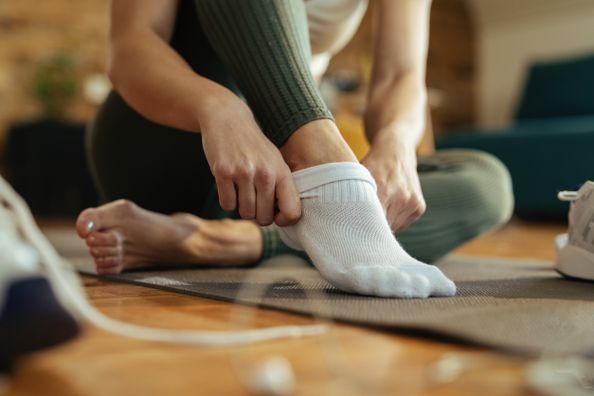Most plantar warts aren’t a serious health concern, but they may be bothersome or painful, and they can be resistant to treatment. You may need to see your Podiatrist to treat and remove plantar warts.
Signs and Symptoms
Plantar warts are often mistaken for corns or calluses. To make the distinction, look for:
- Small, fleshy, grainy bumps on the soles of your feet
- Hard, flat growths with a rough surface and well-defined boundaries
- Gray or brown lumps with one or more black pinpoints, which are actually small, clotted blood vessels, not “wart seeds”
- Bumps that interrupt the normal lines and ridges in the skin of your feet
Causes
You acquire warts through direct contact with the human papillomavirus (HPV). There are more than 100 types of HPV. Some types of HPV tend to cause warts on your hands, fingers or near your fingernails. Others tend to cause warts on your feet.
The virus that causes plantar warts isn’t highly contagious, but it thrives in warm, moist environments, such as shower floors, locker rooms and public swimming areas. So you may contract the virus by walking barefoot in public places.
Like other infectious diseases, HPV may also pass from person to person. If you have a plantar wart, you can even spread the virus to other places on your own foot by touching or scratching. The virus can also spread by contact with skin shed from a wart.
Each person’s immune system responds to warts differently, so not everyone who comes in contact with HPV develops warts.
Risk factors
Plantar warts are more likely to appear on the feet of people with:
- Multiple exposures to the virus
- Damaged or cut skin
- Sweaty skin
For reasons doctors don’t understand, some people are more susceptible to the wart-causing virus, just as some people are more likely to catch a cold. Children and teenagers tend to be especially vulnerable to plantar warts.
When to seek medical advice
See your doctor if warts persist, multiply or recur, despite home treatment, or if warts interfere with your activities. Also see your doctor if your warts are painful or change in appearance or color. If you have diabetes or a circulatory disorder, don’t try to treat any plantar warts at home. Seek treatment from your doctor.
In some cases, you may need to consult your doctor to ensure a correct diagnosis. It’s possible for more serious lesions to appear on your feet, including cancerous tumors called carcinomas and melanomas.
Diagnosis
In most cases, your doctor can diagnose plantar warts just by inspecting your feet. If there’s any doubt, your doctor may need to pare down the lump with a scalpel. Why? Corns and calluses don’t have a blood supply and won’t bleed, while plantar warts will show signs of pinpoint bleeding from their dark dots, which are really blood vessels.
If there’s still doubt about the diagnosis, your doctor may take a sample of your foot tissue and send it to a laboratory for analysis.
Complications
Plantar warts can be persistent. They can shed the virus into the skin of your foot before they’re treated, prompting new warts to grow as fast as the old ones disappear. The best defense is to treat new warts as quickly as possible so that they have little time to spread.
If untreated, warts can swell to an inch or more in circumference and they can spread, developing into clusters of warts called mosaic warts. They may also become extremely painful. If you have lots of plantar warts, the pain may make it difficult for you to walk or run.
Treatment
Plantar warts usually need some type of treatment. Warts on the feet can be particularly persistent and difficult to treat. Unless you have an impaired immune system or diabetes or are pregnant, there’s no reason you can’t try to treat warts with over-the-counter remedies. But you may wish to consult your doctor for additional help.
No wart treatment works 100 percent of the time. In general, your doctor will recommend the least painful — and least destructive — methods first, especially for children.
Common treatments for simple plantar warts
Your doctor may suggest trying these common treatments one at a time or in combination:
- Over the Counter Salicylic acid Wart medications and patches are available at drugstores. To treat plantar warts, you’ll need a salicylic acid solution or patch which peels off the infected skin a little bit at a time. Apply the solution once or twice each day, being careful to avoid healthy skin, which can become irritated from the acid. In between applications, pare away the dead skin and wart tissue using a pumice stone or emery board. You may need to repeat this process for up to three or four weeks to completely eliminate warts.
- Duct tape In a well-publicized 2002 study, duct tape wiped out more warts than freezing (cryotherapy) did. Study participants who used “duct tape therapy” covered their warts in duct tape for six days, then soaked their warts in water, and gently rubbed warts with an emery board or pumice stone. They repeated this process for up to two months or until their warts went away. Researchers hypothesize that this unconventional therapy may work by irritating warts and the surrounding skin, prompting the body’s immune system to attack. Today, duct tape is commonly used to treat warts, especially for children who may find freezing painful or scary. It’s often combined with salicylic acid.
- Freezing (cryotherapy) Freezing is one of the most common treatments for plantar warts and is sometimes effective, but may require multiple trips to your doctor every two to four weeks. Your doctor can apply liquid nitrogen with a spray canister or cotton-tipped applicator. The chemical causes a blister to form around your wart, and the dead tissue sloughs off within a week or so. Freezing isn’t commonly used in young children because it can be painful.
- Cantharidin Doctors and healers have used cantharidin — a substance extracted from the blister beetle — to treat warts for centuries. Your doctor paints this beetle juice onto your wart and covers it with clear tape. The application is initially painless, but it causes the skin under the wart to blister, lifting the wart off the skin. Your doctor can then clip away the dead part of the wart in about a week. Sometimes the blisters are painful but this is of the most effective treatments available.
Aggressive treatments for persistent plantar warts
If your warts don’t respond to common treatments, your doctor may suggest one or more of these other options. Please note each of these treatments has a chance of reoccurrence as well.
Minor surgery This involves cutting away the wart or destroying the wart by using an electric needle in a process called electrodesiccation and curettage. This treatment is effective, but may leave a scar if not done carefully. Your doctor will anesthetize your skin before this procedure.
Laser surgery Doctors can use several types of lasers to eliminate stubborn warts. Surgical and non-surgical types require multiple treatments as well. The effectiveness may vary among patients.
Other medications In severe cases that haven’t cleared with other therapies, your doctor may inject each wart with a medication called bleomycin, which kills the virus. This medication is given systemically in higher doses to treat some kinds of cancer. The injections for wart treatment can be painful and can cause rashes or itching. They’re not used if you’re pregnant or breast-feeding or if you have circulation problems, and used in very extreme circumstances.
Prevention
To reduce your risk of plantar warts:
- Avoid direct contact with warts. This includes your own warts.
- Keep your feet clean and dry. Change your shoes and socks daily.
- Don’t go barefoot in public areas. Wear shoes or sandals in public pools and locker rooms.
- Don’t pick at warts. Picking may spread the virus.
Learn more about our Podiatry team and additional treatment options.
Health Topics:







